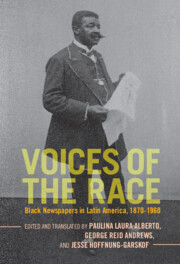Book contents
- Voices of the Race
- Afro-Latin America
- Voices of the Race
- Copyright page
- Dedication
- Contents
- Figures
- Acknowledgments
- A Note on the Text
- Introduction
- Chapter 1 Politics and Citizenship
- Chapter 2 Racism and Anti-Racism
- Chapter 3 Family, Education, and Uplift
- Chapter 4 Community Life
- Chapter 5 Women
- Chapter 6 Africa and African Culture
- Chapter 7 Diaspora and Black Internationalism
- Chapter 8 Arts and Literature
- Appendix Black Periodicals in Argentina, Brazil, Cuba, and Uruguay, 1856–1960
- Glossary
- Bibliography
- Index
Chapter 7 - Diaspora and Black Internationalism
Published online by Cambridge University Press: 25 August 2022
- Voices of the Race
- Afro-Latin America
- Voices of the Race
- Copyright page
- Dedication
- Contents
- Figures
- Acknowledgments
- A Note on the Text
- Introduction
- Chapter 1 Politics and Citizenship
- Chapter 2 Racism and Anti-Racism
- Chapter 3 Family, Education, and Uplift
- Chapter 4 Community Life
- Chapter 5 Women
- Chapter 6 Africa and African Culture
- Chapter 7 Diaspora and Black Internationalism
- Chapter 8 Arts and Literature
- Appendix Black Periodicals in Argentina, Brazil, Cuba, and Uruguay, 1856–1960
- Glossary
- Bibliography
- Index
Summary
Afro-Latin American newspapers included extensive coverage of Black populations in other countries.Articles on Black populations and race relations in Latin America, the United States, and Europe and Africa are examples of “practices of diaspora,” international communication and engagement among Black peoples that grew out of, and helped to forge, feelings of connectedness and racial solidarity.The Black press also reported on, or offered commentary on, more formal political movements promoting Black internationalism, such as Garveyism.Black papers in Argentina and Uruguay reported regularly on their northern neighbor, Brazil. Cuban papers included Puerto Rican and Dominican writers and discussions of Haiti. Throughout Latin America, writers and intellectuals of all races watched with mixed horror and fascination the workings of racial segregation and anti-Blackness in the United States.Diasporic ties were further thickened by travel, migration, and personal connections and friendships among African American and Afro-Latin American writers and intellectuals.
Keywords
- Type
- Chapter
- Information
- Voices of the RaceBlack Newspapers in Latin America, 1870–1960, pp. 255 - 296Publisher: Cambridge University PressPrint publication year: 2022

